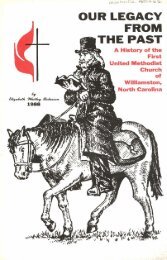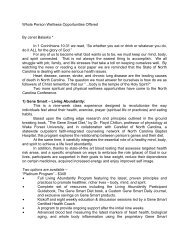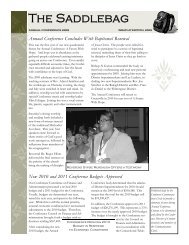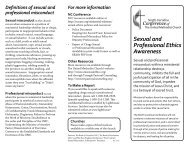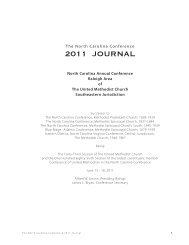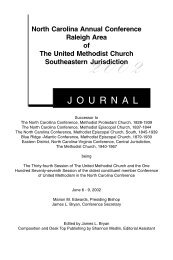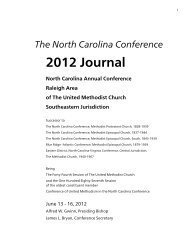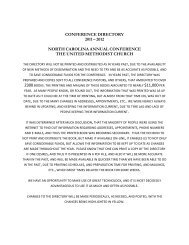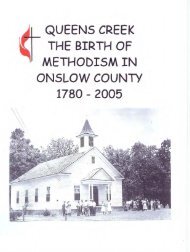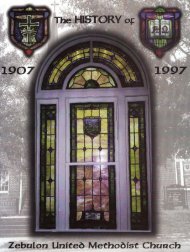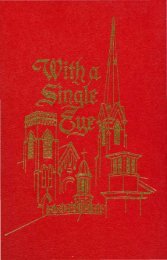Facing Tomorrow, Understanding Yesterday, A History of Orange ...
Facing Tomorrow, Understanding Yesterday, A History of Orange ...
Facing Tomorrow, Understanding Yesterday, A History of Orange ...
Create successful ePaper yourself
Turn your PDF publications into a flip-book with our unique Google optimized e-Paper software.
tolavish praise on the Ladies' Aid Society for being "an organization that<br />
neversuspends, dies, or takes leave <strong>of</strong> absence. It is many things in one:<br />
apastoralreinforcement, a financial treasure chest, a woman's exchange,<br />
arecreation center, a cookery school, a needlework guild, a relief society,<br />
a school <strong>of</strong> salesmanship, a clearing house for domestic and church<br />
problems,a prayer meeting - each in turn plays many parts."?<br />
The women <strong>of</strong> <strong>Orange</strong> Church have followed this tradition. While<br />
constructionon the new church was just getting under way, the ladies <strong>of</strong><br />
thechurch met on February 8, 1924, to organize the Ladies' Aid Society<br />
<strong>of</strong><strong>Orange</strong> Church with thirty-two members. Charter members, as originallylisted,<br />
were Alice Hogan, Novella Hogan, Hattie Hogan, Lillie<br />
Hogan,Pearl Hogan, Ida Hogan, "Miss" Ethel Hogan, Leta Hogan, Mary<br />
Hogan,Lillie Freeland, Lizzie Freeland, Mabel Maddry, Julia Potts,<br />
EmmaPotts, Nellie Hutchins, Minnie Blackwood, Louise Blackwood,<br />
MaryBurch, Margaret N. Burch, Margaret Burch, Alice Craig, Moriah<br />
Collier,Ruth Collier, Pearl Collier, Julia Franklin, Daisy Perkins, Lou<br />
EmelineWeaver, Laura Brockwell, Mrs. M.G. Bishop, and Fannie<br />
Brockwell.Officers elected were: LizzieFreeland, president; Pearl Hogan,<br />
vicepresident; Daisy Perkins, secretary; and Lillie Hogan, treasurer. The<br />
membershipcommittee consisted <strong>of</strong> Moriah Collier, Margaret N. Burch,<br />
andDaisy Perkins. A membership fee was set at 10 cents per person per<br />
month.<br />
Sincethe church building was under construction, the ladies logically<br />
turnedtheir attention to raising funds for the sanctuary. The means used<br />
wouldbe most familiar to present-day church members, for the women<br />
servedsuppers to the Rotary and Kiwanis Clubs <strong>of</strong> Chapel Hill,gave plays,<br />
heldbazaars, and made quilts for sale. During 1924, for instance, the<br />
womenraised $800.02. They gave $200 to the building fund, and the<br />
remainderwas used for furnishings <strong>of</strong> the church, etc.<br />
Still looking for additional sources <strong>of</strong> revenue, in April 1924, the<br />
Ladies'Aid Society decided it was time to transfer any money that the old<br />
CommunityClub still had in the treasury to the Ladies' Aid Society in<br />
orderto buy a piano for the church. Since the Community Club had<br />
includedmembers who did not attend <strong>Orange</strong> Church, permission for<br />
sucha transfer had to be obtained from all <strong>of</strong> the outside members. They<br />
agreedwith the Ladies' Aid Society's plans, and $123.60 was turned over<br />
toSamBrockwell, who had contributed $25 toward the piano's purchase.<br />
Theactual cost <strong>of</strong> the piano is unknown.<br />
Activities <strong>of</strong> the Ladies' Aid Society caught the attention <strong>of</strong> the local<br />
newspaper,and the Chapel Hill Weekly <strong>of</strong> May 22, 1924, reported that<br />
churchmembers sponsored a play, 'The Awful Aunt," at the Blackwood<br />
Schoolto help retire the building debt. The play was scheduled to coincide<br />
witha bazaar at which the women planned to sell handicraft items. The<br />
marriedladies agreed to make a quilt for the bazaar, and the single ladies<br />
eachdecided to make some kind <strong>of</strong> fancy work. All proceeds were to go<br />
forthechurch. The play was held outside the school. As with many <strong>of</strong> the<br />
projects<strong>of</strong>that day, churches cooperated in setting the project in motion.<br />
TheMethodists and the Baptists, for instance, built the stage for the play.<br />
Fivemen - Malcolm C. Blackwood, John H. Maddry, James A. Maddry,<br />
CharlieO. Hogan, and William C. Freeland - were appointed to keep<br />
orderon the outside. Clyde Hogan and Lawrence Blackwood served as<br />
doorkeepers, and Henry Burch, Ernest Turrentine, and Clarence<br />
Blackwoodkept order inside. Lest you think that the audience was unruly,<br />
EugeneBlackwood recalls that the rowdiness was part <strong>of</strong>the play.Among<br />
those performing in the play were Minnie Blackwood, Nell Maddry<br />
Jenkins, Frank Maddry, Foster Tapp, Eugene Blackwood, Louise<br />
Blackwood,Mary Hogan, Pearl Turrentine, Ruth Wright, Jim Wright,<br />
Etoy Byrd, LeRoy Byrd, Ollie Byrd, Lizzie Pendergrass, and Iody<br />
Pendergrass.Admission was 25 cents for adults and 15cents for children.<br />
Membersraised about $140 through that dramatic effort.<br />
FACING TOMORROW, UNDERSTANDING YESTERDAY 21



